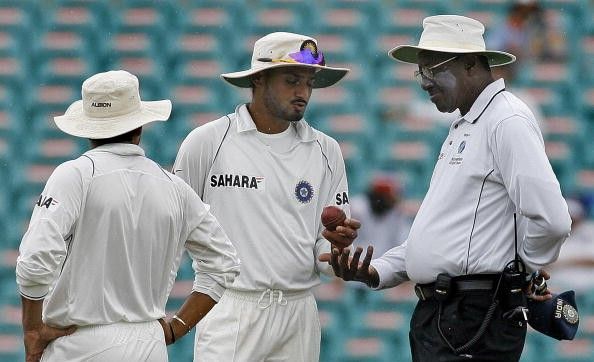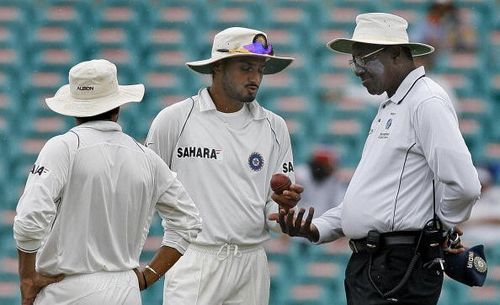
The DRS: Debatable Review System

Blunders, howlers and humans go hand in hand. But when blunders, howlers and humans romance like lovers longing lust, only Christ can intervene. And here goes a tale of a Test between twenty-two fine cricketers from Australia and India, notorious for a duo of supervising sapiens swinging not only this game but also a hundred heads across the cricketing World.
At the turn of the year, Sydney hosted the second Test of the Border-Gavaskar Trophy of 2007-08. And New Year commenced with one gaffe chasing the other. Morning showed the day, as Australian captain Ricky Ponting was destined to be seventh-time dismissed by off-spinner Harbhajan Singh in eight Tests - ironically through an inside edge adjudged as leg before wicket - as English umpire Mark Benson declined India a wicket when the former edged one down the leg to MS Dhoni off Sourav Ganguly.
Ponting eventually left for 55 than 17. India had the hosts reduced to 135 for 6, and eight runs later, Caribbean umpire Steve Bucknor turned a deaf ear to Andrew Symonds’ clean and clear outside edge on 30 to Dhoni from a good length Ishant Sharma delivery.
The clumsily-haired Symmo, on 48, was anon the batsman when, this time, the third umpire joined his on-field colleagues in grotesques galore. Bruce Oxenford, following five varying-angle looks at an agile piece of glovework from the Indian wicketkeeper - afresh - ruled Symonds ‘not out’, though his shadow showed his foot was in the air when Dhoni dispatched the bails; and Bucknor newly came to the Australian’s rescue on refusing to refer a close stumping off Harbhajan to the third umpire. And Symonds managed a career-best unbeaten 162.
So much happened on the first day itself that former Australian captain Steve Waugh appealed for the best umpires to officiate in high-profile matches such as this and called for the concept of neutral umpires to be eradicated, asking for the world’s numero uno umpire for the last four years, Simon Taufel, presence to make crucial decisions. And while the Test continued, Cricket Australia’s CEO James Sutherland confessed ‘player referrals may help umpires’.
Sadly, these comments kept unfazed the irresponsibility of Benson and Bucknor. Australia, with fourteen consecutive victories in Tests under Ricky Ponting - after sixteen during Waugh’s leadership in 2001 - saw a draw imminent, with India not thinking otherwise, as the visitors were set an unlikely 333 with three-quarters of day five left. However, horrible decision-making returned to haunt India; and this time, when they batted - and later ‘battled’ - to save the Test.
Symonds had the red Kookaburra in his hands this time, when Bucknor heard an outside-edge off Rahul Dravid’s bat out of nowhere, and with Adam Gilchrist, along with the entire Australian team, celebrating as if the World had been won, pressuring Bucknor into ruling in their favour, he amazingly did. Dravid departed with a shake of the head and a smirk as if to taunt the spectacled West Indian.
It was time, that India faced shame again during their second innings. Sourav Ganguly, unfortunate with the ball on Day One, fell to a verdict deserving to be tagged ‘cheap’. India’s best batsman thus far in the series was adjudged as ‘dismissed’ when his outside edge fell way short of a diving Michael Clarke - Australia’s captain-in-waiting - at second slip, and bounced off the grass, only for him and his mates to jump in jubilance to another horror. As an alarmed Ganguly stood his ground, Ricky Ponting confirmed from his dishonest fielder the cleanliness of the catch and daringly pointed his index finger skywards, instructing the umpire at the bowler’s end - Mark Benson - to declare it ‘out’. One disgrace followed the other. The first to 10,000 runs in Test cricket, Sunil Gavaskar, called it “utter nonsense” while on commentary duty for Star, as a dumbstruck Ganguly returned to the dressing room.
To sum it up, Michael Clarke finished it off with three wickets in the dying moments of that sunny Sunday, as Australia went 2-0 up in the series. They won fifteen Tests in a row - one shy of the Australian record. It didn’t take many words for India’s distraught captain Anil Kumble to express his disappointment at the international umpires’ and his opposition’s deeds, though - “only one team played in the spirit of the game.”
An official complaint was also lodged to the ICC for the flaw-filled professionalism of the umpires. Such was the impact of the horrendous umpiring that he and his men sought Bucknor’s axing from the subsequent Perth Test and succeeded.
And flaws were exposed by them in the Western Australia capital too - this time, the Australian team was found short of its ground - as India stamped a 72-run defeat on the Kangaroos on one of the fastest pitches - the fastest for an Australian - in the World. The WACA witnessed Australia’s first loss since 1997, and also the high-flying hosts’ first home failure since Adelaide 2003 - who the winner was doesn’t require a reminder - besides curbing their haul of maximum Test victories, a replica of Calcutta 2001. The annihilation was typical of a demolition, as the proud ‘victors’ of Sydney were bowled out for 212 in the first innings, their lowest since the Lord’s Test of 2005. Nineteen-year-old Ishant Sharma’s fluent setting-up - and then dismissal - of the Australian captain on the fourth afternoon demonstrated India’s dominance.
The poor work even prompted rumours that India were ready to call off the tour. But dirt gave birth to delight, with technology’s maximum productivity in cricket, as the ICC introduced the Decision Review System (DRS), wherein the batsman or bowler feeling undone by could ask for a review to the on-field umpire, who would then pass it on to his TV compatriot. Funnily enough, this commenced with a series involving India, when they toured Sri Lanka six months after the Sydney disaster.
Progressing to today, seven years post the DRS’ birth, all Test-playing nations don’t stand on the same side of the fence, and one even stands behind another. While the English and Australians can afford the expensive technology of Hot Spot, wherein the ball, if in contact with the bat or pad would distinctly be visible by the presence of a round white spot on the blackened batsman, the other Boards still continue sans it. Another guide to the correct call is the ‘ Hawk Eye’, a ball-tracking technology to capture direction of the ball, while a third lead up towards the true verdict is called the Snickometer, in which case the meter would immediately dance up and down immediately as the ball banged into the bat or pad.
The ICC is yet to make it mandatory in all bilateral series due to India’s continued antagonistic views while it has been carried on in all ICC tournaments since the 2011 World Cup in the subcontinent.
Without digging deep into the gift called statistics, let us first count on the optimism of the system. While it may be harsh to expect every on-field umpire to get each LBW appeal’s - or any other doubtful incident for that matter - answer bang on target, here is where the DRS interferes. The aggrieved party can well protest and call for help. Last June, when Sri Lanka’s Nuwan Pradeep was adjudged ‘out’ by Paul Reiffel in the last over of Day 5 with hosts England only one wicket away from a 1-0 lead in the series, the decision was immediately reviewed by him, only to have the last laugh; Sri Lanka held on to a draw and clinched the next Test at Headingly to win the series 1-0.
The process of review has only helped cricket get fairer, with no opportunity to complain later; with tennis using player reviews and football goal-line technology, lagging behind in terms of enhancement of the game would any day remain unfavoured. The added advantage which it brings is that with the presence of the DRS, the authority on the park is under severe pressure to get his finger up - or keep it down - at the right time, for he knows too well that with the slightest of suspicion, the third umpire can thoroughly look after things.
A World Cup final can be soon decided by the controversial DRS; a career can sooner be saved by the disputable DRS.
Pessimism, they say, is just another thought. The DRS has its share of negatives. Smile if you’re associated to the BCCI. There is no suspense it is the only cricket board opposing the technology on offer. They claim it is not foolproof. They allege the standing umpires must be trusted. They have refused to use the aid provided by their bosses. No series that India has played - at home and away - ever since the DRS came into the picture has included its benefits, though when they travelled to England in 2011, it was used for decisions other than LBWs, beating its purpose entirely. It is, but a blunt lie, that the DRS failed to provide India any success at all five global competitions since.
But their protest has continued for the minor blips that DRS contains. Scarcely does the Hot Spot fail to leave a stamp when the ball only kisses the edge of the bat. Barely does the Snickometer stay static even as a nick is apparently audible. Talking of the latter, the first incident to strike absolutely anybody’s mind is the beastly ruling by Kumar Dharmasena against Australia’s Usman Khawaja at Old Trafford in 2013. When on 1, his bat hitting the pad and the turning ball carrying to wicketkeeper Matt Prior off Graeme Swann was first adjudged out by Tony Hill on the field; when Khawaja reviewed, Sri Lankan Dharmasena agreed to Hill. Despite no Hot Spot evidence and the Snickometer clearly reacting on Khawaja’s bat-pad collision, Hill and Dharmasena heard the away-moving ball take the edge.
Nobody knows how many Khawaja would have gone on to score, but only Khawaja knows the pain of having represented his country only once - in the subsequent Test - since. With the naked eye knowing all too well that the ball and bat were as far away as first slip and ‘keeper, Khawaja had to walk back peeved. A career stopped midway.
What the DRS might also bring about is a certain casualty amongst the umpires, who might just find comfort in the thought of a false decision, for there sits their mate floors above in an air-conditioned ambience to rectify their errors.
Nevertheless, what the BCCI must realise is that despite technology at only 90%, technology aids. There is no guaranteeing that all will be well with the present health of the DRS. There is no guarantee in any walk of life. For India, despite having a number of their players injured post football drills, still continue with it. Then why not give technology a chance.
Else far is not the day when the ICC pokes in as cricket’s Christ and imposes the DRS into all bilateral series in order to prevent faults and us walking hand in hand.